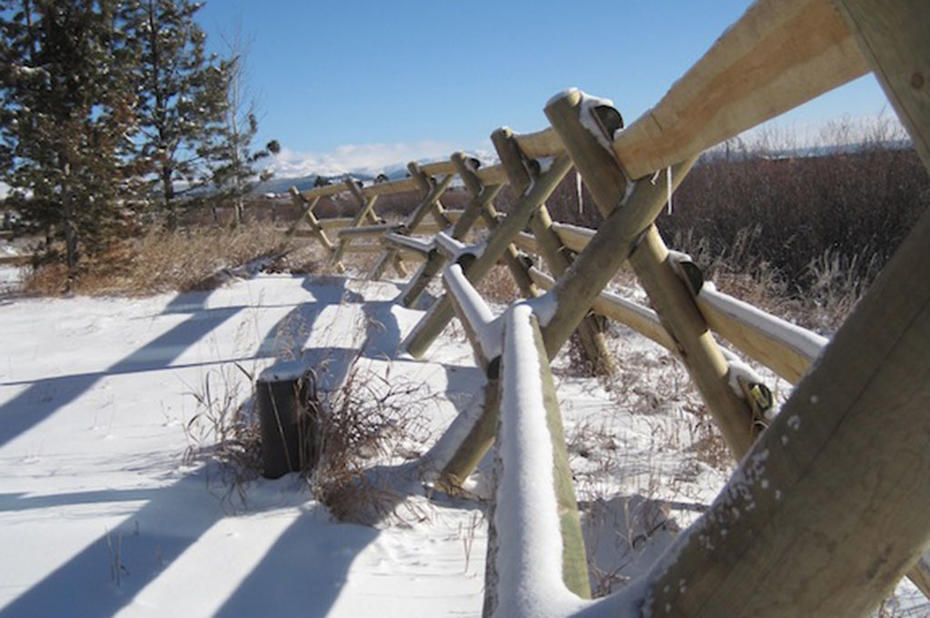The preferred breakfast companions of Karrie Taggart in springtime are bison. Taggart lives on Horse Butte Peninsula, which extends into Montana’s Hebgen Lake. Her small community sits about 10 miles northwest of Yellowstone National Park. “I have my cereal while they’re out there eating grass on the other side of my fence,” Taggart says. “They eat right along it. I swear, I don’t have to use a weed-whacker along the fence line.”
Taggart says having the behemoths, which can top 2,000 pounds, roaming near her home is a privilege. “It’s so interesting to see them going about their daily lives,” she says. “You realize: ‘Oh, the mother is mad.’ Or, ‘The calves are playing!’”
Hundreds of bison migrate to low-elevation habitat outside the park in search of food during the winter, moving onto surrounding public lands and private property (like Taggart’s yard). But when spring comes, the enormous herbivores become fugitives in these parts, and wildlife officials round them up and force them back into the park. “Officials use snowmobiles, ATVs, helicopters, and horses to haze the animals, sometimes right through my neighborhood,” Taggart says. “The bison are aggravated and agitated. It’s heartbreaking and stressful to watch,” she adds.
This spring, however, Taggart may be able to enjoy her big, fury friends a little longer. Montana’s governor, Steve Bullock, announced in December that his administration will be granting bison year-round access to 250,000 acres along Yellowstone’s western border. (Animals that wander outside the new roam zone will continue to be hazed back into it.) The agencies that manage bison, including the National Park Service and the InterTribal Buffalo Council, still have to adopt the change, but the plan is expected to go forward.

“This is a huge deal,” says Matt Skoglund, director of the Natural Resources Defense Council’s Northern Rockies office. “It puts in place a foundation for year-round bison habitat in Montana, which is a great step in the right direction.”
The move is timely, as it comes amid the early stages of revising the Interagency Bison Management Plan. That plan, set in place 16 years ago, calls for hazing bison outside the park due to fears that the animals will transmit brucellosis, a disease that can cause cattle to abort their pregnancies. It also sets the goal population for Yellowstone bison at 3,000—a number that has required the slaughter of thousands of animals (in addition to those killed by tribal and permitted hunters).
A lot has changed since then, says Sam Sheppard, a regional supervisor with Montana Fish, Wildlife, and Parks. First, research hasn’t found any case in which cattle have contracted brucellosis from wild bison (in fact, elk may pose a bigger threat). What’s more, the bacterium that causes the disease doesn’t persist in the landscape as long as previously thought, and by the time the cattle show up later in the summer, the bison have already moved on to higher ground, diminishing concern over brucellosis even further. Also, due to changes in land ownership, few cattle allotments remain where bison roam outside the park. Add it all up, and the conversation surrounding bison has evolved.
“We’re not as constrained as we used to be, with artificial time lines [for forcing bison back into the park] and boundaries that bison ignore,” Sheppard says. “It means that we can start to treat bison like the iconic, native wildlife species they are.” Under the new paradigm, wildlife managers will deal with conflicts between landowners and bison as they arise, as is currently done with grizzlies, wolves, and elk. It will also give them a chance to learn more about these beasts for an updated management plan expected in the next couple of years.
In the meantime, however, bison will likely continue to be slaughtered; this winter, a near-record-high 600 to 900 of the animals face culling. Scientists say that if the bison weren’t killed, the population would increase to nearly 6,000 by the end of the winter—twice the limit put forth in a 2000 court-mediated agreement.

In the future, these annual culls might not be necessary. Sheppard believes if the new plan allows bison to rove naturally across the landscape, hunting could be the primary tool to keep the number of animals in check.
Of course, more bison roaming about also raises the probability of conflict with people, whether the animals are getting into gardens or causing traffic jams. And that’s where the Yellowstone bison co-existence program comes in. Founded five years ago by NRDC, the Greater Yellowstone Coalition, Defenders of Wildlife, and the Sierra Club, the program aims to ease tensions between humans and their neighbors with horns by helping to cover the cost of fencing (up to a maximum of $1,000, in most cases). The project has funded more than 30 fencing projects to date, including the one Taggart’s breakfast buddies keep tidy in the spring.
“I’m on a limited income, and without the help, I wouldn’t have been able to put up a fence,” Taggart says. The way she sees it, fencing bison out of her yard gives them greater freedom to roam (and play and get mad at their calves) elsewhere.

This story originally appeared on Earthwire as “Spring Break” and is re-published here under a Creative Commons license.





